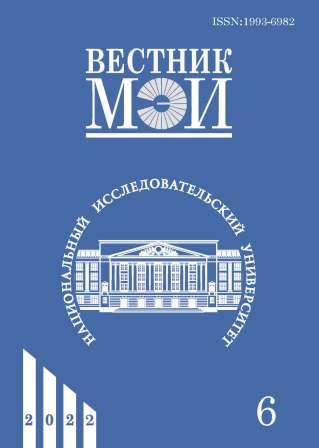Анализ наименьшей электрической нагрузки многоквартирных жилых домов в системах электроснабжения городов
Аннотация
В настоящее время значительная часть исследований электрической нагрузки жилого многоквартирного дома касается только анализа максимальной нагрузки на вводе в жилой дом и на шинах питающей жилые дома трансформаторной подстанции. Однако для полноценного анализа электропотребления жилого многоквартирного дома необходимо оценивать не только максимальную мощность на вводе, но и минимальную нагрузку. Приведены результаты анализа электропотребления многоквартирных жилых домов с электрическими плитами (на примере г. Москвы). Исходными данными для анализа стало электропотребление за несколько лет восьми многоквартирных жилых домов, зафиксированное электрическими счетчиками на вводных распределительных устройствах рассматриваемых зданий каждые тридцать минут. Рассмотрена динамика изменения минимальной электрической нагрузки в разрезе года, выполнена оценка зависимости величины минимальной мощности от температуры наружного воздуха, установлены время суток, день недели и месяца, в которых наблюдается минимум электрической нагрузки жилого дома. Определены закон распределения случайной величины — времени, в котором наблюдается абсолютный годовой минимум электрической нагрузки жилого дома, и её характеристики — математическое ожидание и среднеквадратичное отклонение. Представлены результаты сопоставительного анализа абсолютной годовой минимальной и максимальной (расчетной) нагрузок на вводе многоквартирных жилых домов.
Литература
2. Российский статистический ежегодник [Офиц. сайт] https://gks.ru/bgd/regl/b20_13/Main.htm (дата обращения 05.07.2022).
3. Demidenko A., Kudelina S., Parfenov G., Shvedov G. Analysis of the Lighting Load Contribution in Modern Apartments // Proc. International Ural Conf. Electrical Power Eng. 2021. Pp. 168—172.
4. Олова Г.А., Медведев В.П., Сабельников Л.В., Воронина В.Н. Развитие мирового рынка кондиционеров воздуха бытового назначения // Российский внешнеэкономический вестник. 2021. № 4. С. 13—22.
5. Солуянов Ю.И., Ахметшин А.Р., Солуянов В.И. Энергоресурсосберегающий эффект в системах электроснабжения жилых комплексов от актуализации нормативов электрических нагрузок // Известия высших учебных заведений. Серия «Проблема энергетики». 2021. Т. 23. № 1. С. 156—166.
6. Shvedov G.V. e. a. Analysis of the Maximum Electrical Load of Multi-apartment Residential Buildings in the Power Supply Systems of Cities // Proc. 4th Intern. Youth Conf. Radio Electronics, Electrical and Power Eng. Moscow: NRU «MPEI», 2022.
7. Чернышова Т.И., Кобелев А.В., Кочергин С.В., Зяблов Н.М. Прогнозирование бытовой электрической нагрузки с применением нейронных сетей // Модели, системы, сети в экономике, технике, природе и обществе. 2017. № 1(21). C. 181—190.
8. Шведов Г.В. Электроснабжение городов: электропотребление, расчетные нагрузки, распределительные сети. M.: Издательский дом МЭИ, 2012.
9. Gismeteo [Офиц. сайт] https://www.gismeteo.ru/diary (дата обращения 05.07.2022).
10. Вентцель Е.С., Овчаров Л.А. Теория вероятностей и ее инженерные приложения. M.: Высшая школа, 2000.
---
Для цитирования: Морсин И.А., Шведов Г.В. Анализ наименьшей электрической нагрузки многоквартирных жилых домов в системах электроснабжения городов // Вестник МЭИ. 2022. № 6. С. 43—50. DOI: 10.24160/1993-6982-2022-6-43-50
#
1. Proedrou E. A Comprehensive Review of Residential Electricity Load Profile Models. IEEE Access. 2021;9:12114—12133.
2. Rossiyskiy Statisticheskiy Ezhegodnik [Ofits. Sayt] https://gks.ru/bgd/regl/b20_13/Main.htm (Data Obrashcheniya 05.07.2022). (in Russian).
3. Demidenko A., Kudelina S., Parfenov G., Shvedov G. Analysis of the Lighting Load Contribution in Modern Apartments. Proc. International Ural Conf. Electrical Power Eng. 2021:168—172.
4. Olova G.A., Medvedev V.P., Sabel'nikov L.V., Voronina V.N. Razvitie Mirovogo Rynka Konditsionerov Vozdukha Bytovogo Naznacheniya. Rossiyskiy Vneshneekonomicheskiy Vestnik. 2021;4:13—22. (in Russian).
5. Soluyanov Yu.I., Akhmetshin A.R., Soluyanov V.I. Energoresursosberegayushchiiy Effekt v Sistemakh Elektrosnabzheniya Zhilykh Kompleksov ot Aktualizatsii Normativov Elektricheskikh Nagruzok. Izvestiya Vysshikh Uchebnykh Zavedeniiy. Seriya «Problema Energetiki». 2021;23;1:156—166. (in Russian).
6. Shvedov G.V. e. a. Analysis of the Maximum Electrical Load of Multi-apartment Residential Buildings in the Power Supply Systems of Cities. Proc. 4th Intern. Youth Conf. Radio Electronics, Electrical and Power Eng. Moscow: NRU «MPEI», 2022.
7. Chernyshova T.I., Kobelev A.V., Kochergin S.V., Zyablov N.M. Prognozirovanie Bytovoy Elektricheskoy Nagruzki s Primeneniem Neyronnykh Setey. Modeli, Sistemy, Seti v Ekonomike, Tekhnike, Prirode i Obshchestve. 2017;1(21):181—190. (in Russian).
8. Shvedov G.V. Elektrosnabzhenie Gorodov: Elektropotreblenie, Raschetnye Nagruzki, Raspredelitel'nye Seti. M.: Izdatel'skiy Dom MEI, 2012. (in Russian).
9. Gismeteo [Ofits. Sayt] https://www.gismeteo.ru/diary (Data Obrashcheniya 05.07.2022). (in Russian).
10. Venttsel' E.S., Ovcharov L.A. Teoriya Veroyatnostey i ee Inzhenernye Prilozheniya. M.: Vysshaya Shkola, 2000. (in Russian)
---
For citation: Morsin I.A., Shvedov G.V. Analysis of the Minimum Electrical Load of Residential Apartment Buildings in Urban Power Supply Systems. Bulletin of MPEI. 2022;6:43—50. (in Russian). DOI: 10.24160/1993-6982-2022-6-43-50




